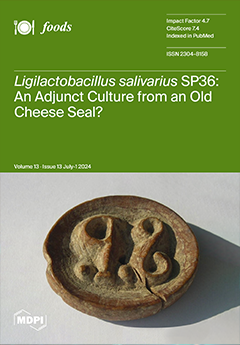Microalgae are exceptional organisms from a nutritional perspective, boasting an array of bioactive compounds that have long justified their incorporation into human diets. In this study, we explored the potential of five microalgae species:
Nannochloropsis sp.,
Tetraselmis chuii,
Chaetoceros muelleri,
Thalassiosira weissflogii, and
Tisochrysis lutea. We conducted comprehensive analyses of their nutritional profiles, encompassing protein content, individual amino acid composition, mineral and trace element levels, fatty acid profiles (including saturated fatty acids (SFAs), monounsaturated fatty acids (MUFAs), and polyunsaturated fatty acids (PUFAs)), polyphenol compositions, and vitamin B content. The antioxidant activity of the ethanolic extracts was evaluated using two methods: ABTS and DPPH radical scavenging assay. The total protein content of the microalgae ranged from 34.09 ± 0.39% to 42.45 ± 0.18%, with the highest concentration observed in
T. weissflogii. Essential amino acids such as histidine, threonine, lysine, valine, isoleucine, leucine, phenylalanine, and methionine were present in concentrations ranging from 0.53 ± 0.02 to 12.55 ± 2.21 g/16 g N. Glutamic acid emerged as the most abundant amino acid, with concentrations ranging from 6.73 ± 0.82 to 12.55 ± 2.21 g/16 g N. Among the microalgae species,
T. chuii exhibited the highest concentrations of calcium (Ca) and manganese (Mn), while
C. muelleri showed prominence in magnesium (Mg), sodium (Na), and iron (Fe).
T. weissflogii stood out for its potassium (K) content, and
T. lutea contained notable amounts of copper (Cu), zinc (Zn), and lead (Pb). Regarding fatty acid profiles,
Nannochloropsis sp. and
T. chuii were predominantly composed of SFA, while
C. muelleri and
T. weissflogii were rich in MUFA. PUFAs dominated the fatty acid profile of
T. lutea, which also exhibited the most diverse range of polyphenolic substances. We also analyzed the B vitamin content, with
T. lutea displaying the highest concentrations of niacin (B
3) and riboflavin (B
2). Antioxidant activity was confirmed for all microalgae tested using DPPH and ABTS radical IC
50 (mg/mL) converted to Trolox equivalent (TEAC). These findings underscore the substantial potential of the examined microalgae species as sources of biologically valuable substances characterized by rapid growth and relatively undemanding cultivation conditions.
Full article






